Relationship between Organic Geochemistry and Reservoir Characteristics of the Wufeng-Longmaxi Formation Shale in Southeastern Chongqing, SW China
Abstract
:1. Introduction
2. Geological Setting
3. Methods
4. Results
4.1. Organic Geochemical Characteristics
4.1.1. Total Organic Carbon Content
4.1.2. Types of Organic Matter (OM)
4.1.3. Maturity of Organic Matter (OM)
4.2. Reservoir Characteristics
4.2.1. Mineral Composition
4.2.2. Physical Characteristics
Porosity and Permeability
Pore Structure and Adsorption Capacity: High Pressure Mercury Injection
Pore Structure and Adsorption Capacity: Nitrogen Adsorption
Pore Structure and Adsorption Capacity: Isothermal Adsorption
4.2.3. Pore Types
Inorganic Pores
Organic Pores
Micro Fractures
5. Discussion
5.1. Relationship between OM Content and Mineral Composition
5.2. Relationship between Mineral Composition and Reservoir Physical Properties
5.3. Relationship between TOC and Reservoir Physical Properties
5.4. Coupling Characteristics
5.5. Revelations of Shale Gas Exploration
6. Conclusions
Author Contributions
Funding
Institutional Review Board Statement
Informed Consent Statement
Data Availability Statement
Acknowledgments
Conflicts of Interest
References
- Loucks, R.G.; Reed, R.M.; Rrppel, S.C.; Hammes, U. Spectrum of pore types and networks in mud rocks and descriptive classification for matrix-related mud rocks pore. AAPG Bull. 2012, 96, 1071–1098. [Google Scholar] [CrossRef] [Green Version]
- Loucks, R.; Ruppel, S. Mississippian Barnett shale: Lithofa-cies and depositional setting of a deep-water shale-gas succession in the Fort Worth basin, Texa. AAPG Bull. 2007, 91, 579–601. [Google Scholar] [CrossRef] [Green Version]
- Curtis, M.E.; Cardott, B.; Sondergeld, C.H.; Rai, C.S. Development of organic porosity in the Woodford Shale with increasing thermal maturity. Int. J. Coal Geol. 2012, 103, 26–31. [Google Scholar] [CrossRef]
- Ross, D.J.; Bustin, R. Characterizing the shale gas resource potential of Devonian-Mississippian strata in the Western Canada sedimentary basin: Application of an integrated formation evaluation. AAPG Bull. 2008, 92, 87–125. [Google Scholar] [CrossRef]
- Jinchuan, Z.; Xu, B.; Haikuan, N.; Zongyu, W.; Lin, T. Exploration potential of shale gas resources in China. Nat. Gas Ind. 2008, 28, 136–140. [Google Scholar]
- Caineng, Z.; Songqi, P.; Qun, Z. On the connotation, challenge and significance of China’s “energy independence” strategy. Pet. Explor. Dev. 2020, 47, 416–426. [Google Scholar]
- Xusheng, G. Controlling factors on shale gas accumulations of Wufeng-Longmaxi Formations in Pingqiao shale gas field in Fuling area, Sichuan Basin. Nat. Gas Geosci. 2019, 30, 1–10. [Google Scholar]
- Zhenxue, J.; Yan, S.; Xianglu, T.; Zhao, L.; Xingmeng, W.; Guozhen, W.; Zixin, X.; Xin, L.; Kun, Z.; Jiaqin, C.; et al. Controlling factors of marine shale gas differential enrichment in southern China. Pet. Explor. Dev. 2020, 47, 617–628. [Google Scholar]
- Jinlei, L.; Cheng, Y.; Mingfei, W.; Shasha, Y.; Xiaojing, L.; Chao, C. Preservation condition differences in Jiaoshiba area, Fuling, Sichuan Basin. Petrol. Geol. Exper. 2019, 41, 341–347. [Google Scholar]
- Zhen, Q.; Caineng, Z.; Hongyan, W.; Dazhong, D.; Bin, L.; Zhenhong, C.; Dexun, L.; Guizhong, L.; Hanlin, L.; Jianglin, H.; et al. Discussion on characteristics and controlling factors of differential enrichment of Wufeng-Longmaxi formations shale gas in South China. J. Nat. Gas. Geosci. 2020, 5, 117–128. [Google Scholar]
- Chenglin, Z.; Jian, Z.; Wuguang, L.; Chong, T.; Chao, L.; Shengxian, Z.; Wenwen, Z. Deep shale reservoir characteristics and exploration potential of Wufeng-Longmaxi Formations in Dazu area, western Chongqing. Nat. Gas. Geosci. 2019, 30, 1794–1804. [Google Scholar]
- Gomaa, S.; Emara, R.; Mahmoud, O.; El-Hoshoudy, A.N. New correlations to calculate vertical sweep efficiency in oil reservoirs using nonlinear multiple regression and artificial neural network. J. King Saud Univ.-Eng. Sci. 2021, in press. [Google Scholar] [CrossRef]
- Adegbite, J.O.; Belhaj, H.; Bera, A. Investigations on the relationship among the porosity, permeability and pore throat size of transition zone samples in carbonate reservoirs using multiple regression analysis, artificial neural network and adaptive neuro-fuzzy interface system. Pet. Res. 2021, in press. [Google Scholar] [CrossRef]
- Ghareb, H.; Veronique, J. Developed correlations between sound wave velocity and porosity, permeability and mechanical properties of sandstone core samples. Pet. Res. 2020, 5, 326–338. [Google Scholar]
- Powley, D. Pressures and hydrogeology in petroleum basins. Earth Sci. Rev. 1990, 29, 215–226. [Google Scholar] [CrossRef]
- Yassin, M.; Begum, M.; Dehgahnpour, H. Organic shale wettability and its relationship to other petrophysical properties: A Duvernay case study. Int. J. Coal Geol. 2017, 169, 74–91. [Google Scholar] [CrossRef]
- Tonglou, G. Key geological issues and main controls on accumulation and enrichment of Chinese shale gas. Pet. Explor. Dev. 2016, 43, 317–326. [Google Scholar]
- Tonglou, G.; Ruobing, L. Implications from marine shale gas exploration breakthrough in complicated structural area at high thermal stage: Taking Longmaxi formation in Well JY1 as an example. Nat. Gas Geosci. 2013, 24, 643–651. [Google Scholar]
- Tonglou, G.; Hanrong, Z. Formation and enrichment mode of Jiaoshiba shale gas field, Sichuan Basin. Pet. Explor. Dev. 2014, 41, 31–40. [Google Scholar]
- Martineau, D. History of the Newark East field and the Barnett Shale as a gas reservoir. AAPG Bull. 2007, 91, 399–403. [Google Scholar] [CrossRef]
- Caieng, Z.; Zhi, Y.; Shizhen, T.; Wei, L.; Songtao, W.; Rukai, Z.; Xuanjun, Y.; Lan, W.; Xiaohui, G.; Jinhua, J.; et al. Nano-hydrocarbon and the accumulation in coexisting source and reservoir. Pet. Explor. Dev. 2012, 39, 15–32. [Google Scholar]
- Thanh, H.V.; Sugai, Y.C.; Sasaki, K. Impact of a new geological modelling method on the enhancement of the CO2 storage assessment of E sequence of Nam Vang field, offshore Vietnam. Energy Sources 2020, 42, 1499–1512. [Google Scholar] [CrossRef]
- Jia, W.; Xianfeng, T.; Jingchuan, T.; Long, L.; Xuanbo, G.; Chao, L.; Chunlin, Z.; Lei, Z.; Weiwei, X. The Effect of Diagenetic Evolution on Shale Gas Exploration and Development of the Longmaxi Formation Shale, Sichuan Basin, China. Front. Earth Sci. 2021, 9, 172. [Google Scholar] [CrossRef]
- Thanh, H.V.; Sugai, Y.C. Integrated modelling framework for enhancement history matching in fluvial channel sandstone reservoirs. Upstr. Oil Gas Technol. 2021, in press. [Google Scholar] [CrossRef]
- Zhuo, L.; Zhenxue, J.; Xianglu, T.; Pengfei, W.; Pu, H.; Guozhen, W. Lithofacies Characteristics and Its Effect on Pore Structure of the Marine Shale in the Low Silurian Longmaxi Formation, Southeastern Chongqing. Earth Sci. 2017, 42, 1116–1123. [Google Scholar]
- Jia, W.; Xianfeng, T.; Jingchun, T.; Chao, L.; Tian, R.; Qing, C.; Xia, L.; Chunlin, Z. Constraints of hydrocarbon migration in Longmaxi shale in Sichuan Basin on shale gas accumulation. Pet. Geol. Exp. 2017, 39, 755–762. [Google Scholar]
- Chuanlong, M.; Xiangying, G.; Xiaosong, X.; Kenken, Z.; Wei, L.; Xiuping, W. Lithofacies palaeogeography of the Late Ordovician and its petroleum geological significance in Middle-Upper Yangtze region. J. Palaeogeoraphy 2014, 16, 427–440. [Google Scholar]
- Xusheng, G.; Yuping, L.; Tenger, B.; Qiang, W.; Tao, Y.; Baojian, S.; Zhongliang, M.; Fulbin, W. Hydrocarbon generation and storage mechanisms of deep-water shelf shales of Hydrocarbon generation and storage mechanisms of deep-water shelf shales of, China. Pet. Geol. Exp. 2020, 47, 193–201. [Google Scholar]
- Digang, L.; Tonglou, G.; Jianping, C.; Lizeng, B.; Zhe, Z. Distribution of four suits of regional marine source rocks, South China. Mar. Orig. Pet. Geol. 2008, 13, 1–16. [Google Scholar]
- Peters, K.; Cassa, M. Applied source rock geochemistry. AAPG Bull. 1994, 60, 93–120. [Google Scholar]
- Jacob, H. Dispersed solid bitumens as an indicator for migration and maturity in prospecting for oil and gas. Erdöl Kohle Erdgas Petrochem. 1985, 38, 365–392. [Google Scholar]
- Xiuping, W.; Chuanlong, M.; Qiyu, W.; Xiangying, G.; Xiaowei, C.; Kenken, Z.; Wei, L. Diagenesis of black shale in Longmaxi Formation, southern Sichuan Basin and its periphery. Acta Petrol. Sin. 2015, 36, 1035–1047. [Google Scholar]
- Shugen, L.; Zhiwu, L.; Wei, S.; Zhili, L.; Guozhi, W.; Zhiquan, Y.; Wenming, H. Basic geological features of superimposed baisn and hydrocarbon accumulatuion in Sichuan Basin, China. Chin. J. Geol. 2011, 46, 233–257. [Google Scholar]
- Caineng, Z.; Rukai, Z.; Bin, B.; Zhi, Y.; Songtao, W.; Ling, S.; Dazhong, D.; Xingjing, L. First discovery of nano-pore throat in oil and gas reservoir in China and its scientific value. Acta Petrol. Sin. 2011, 277, 1857–1864. [Google Scholar]
- Haihan, Q.; Yuping, Z.; Ye, Y. An analysis on “double hump distribution of intrusive” mercury curve. Acta Petrol. Sin. 1999, 20, 61–68. [Google Scholar]
- Sing, K.S.W.; Everett, D.H.; Haul, R.A.W.; Moscou, L.; Pierotti, R.A.; Rouquerol, J.; Siemieniewska, T. Reporting phys-isorption data for gas/solid with special reference to the determination of surface systems area and porosity. Pure Appl. Chem. 1985, 57, 603–619. [Google Scholar] [CrossRef]
- Jarvie, D. Unconventional shale resource plays: Shale gas shale oil opportunities. Tex. Word-Wide Geochem. 2008, 7–17. Available online: https://www.yumpu.com/en/document/view/10690125/unconventional-shale-resource-plays-shale-gas-and-shale-oil (accessed on 5 September 2021).
- Shufang, W.; Caineng, Z.; Dazhong, D.; Yuman, W.; Jinliang, H.; Zhaojie, G. Biogenic silica of organic-rich shale in Sichuan Basin and Its significance for shale gas. Acta Sci. Nat. Univ. Pekin. 2014, 50, 476–486. [Google Scholar]
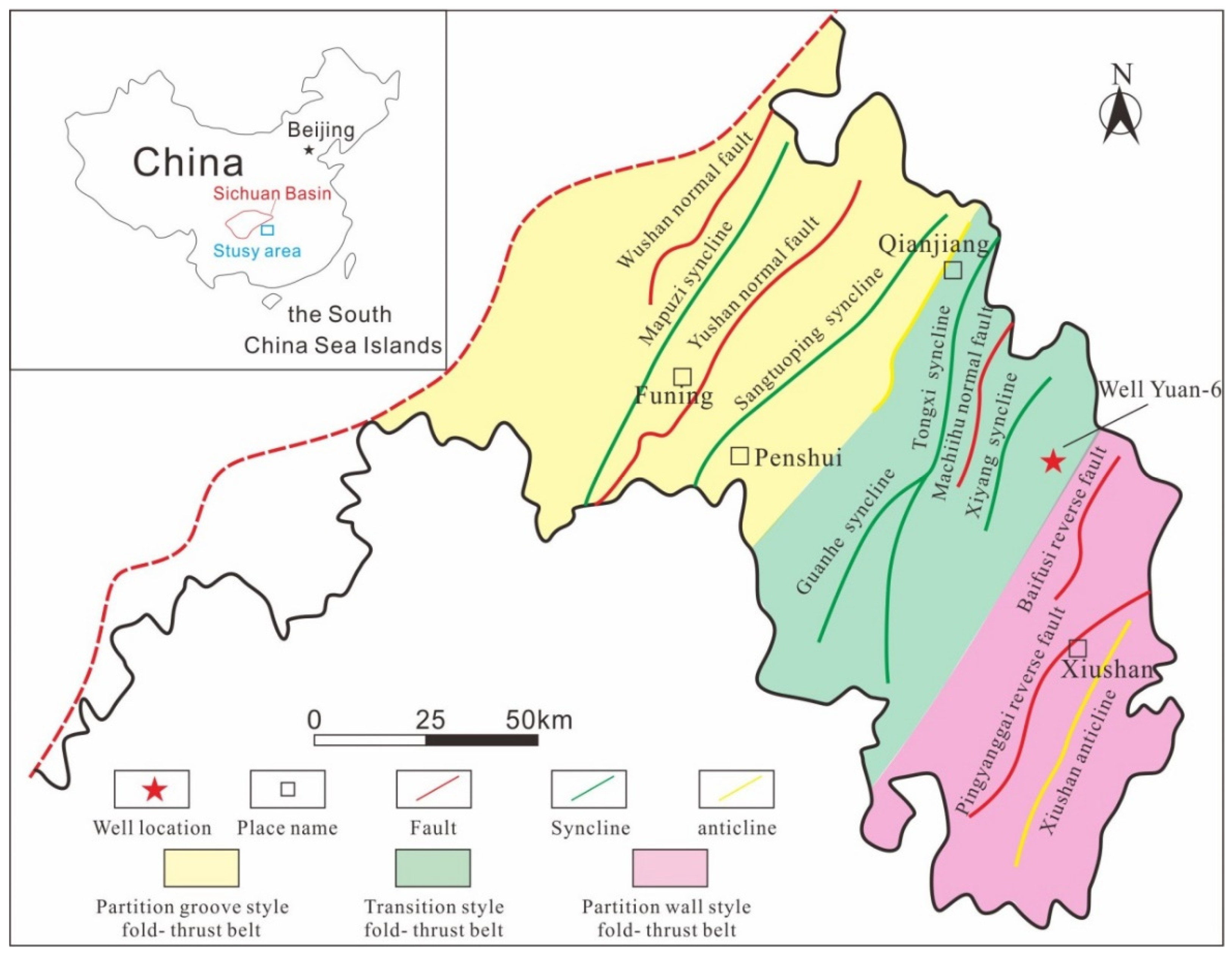
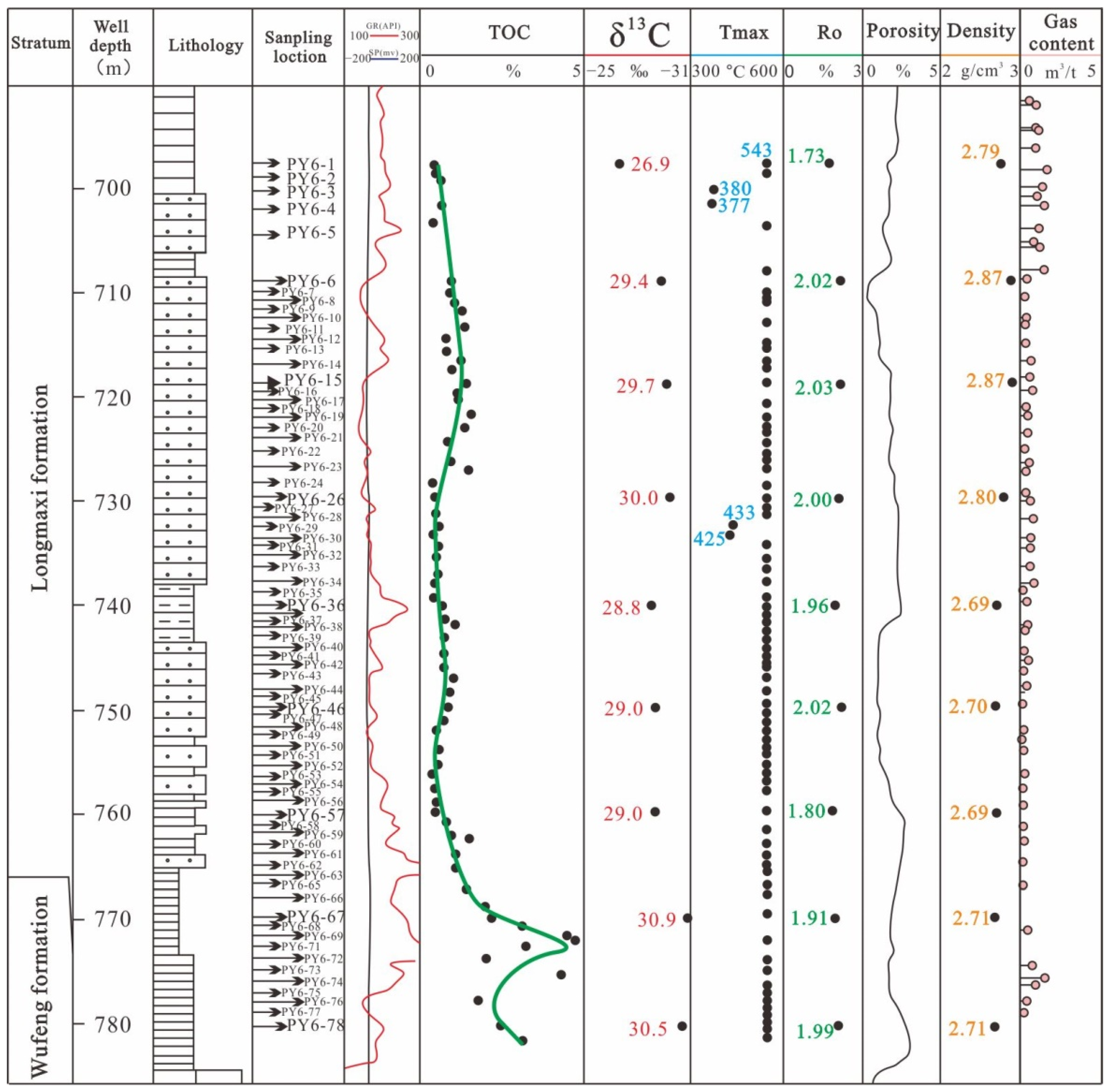
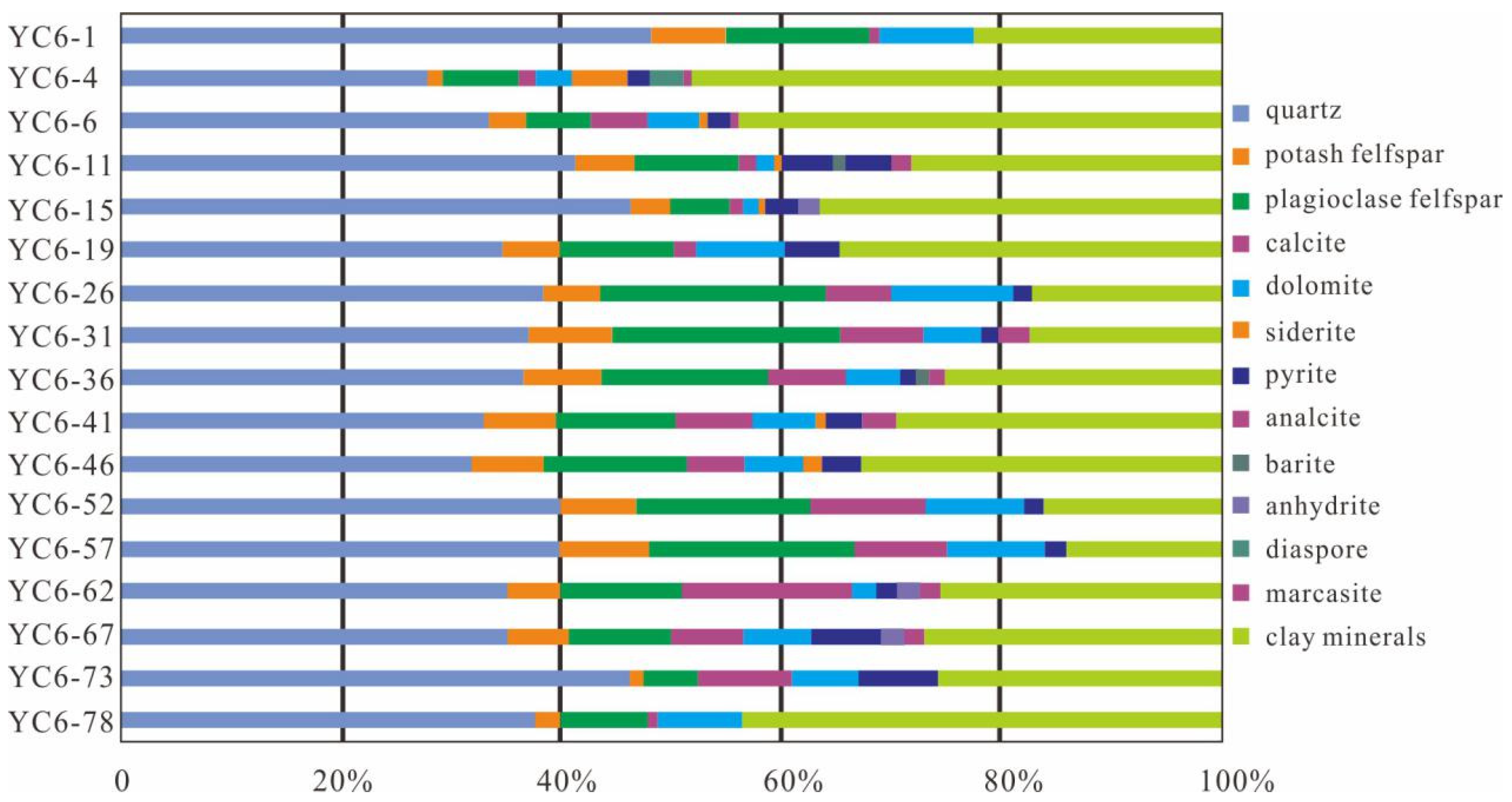
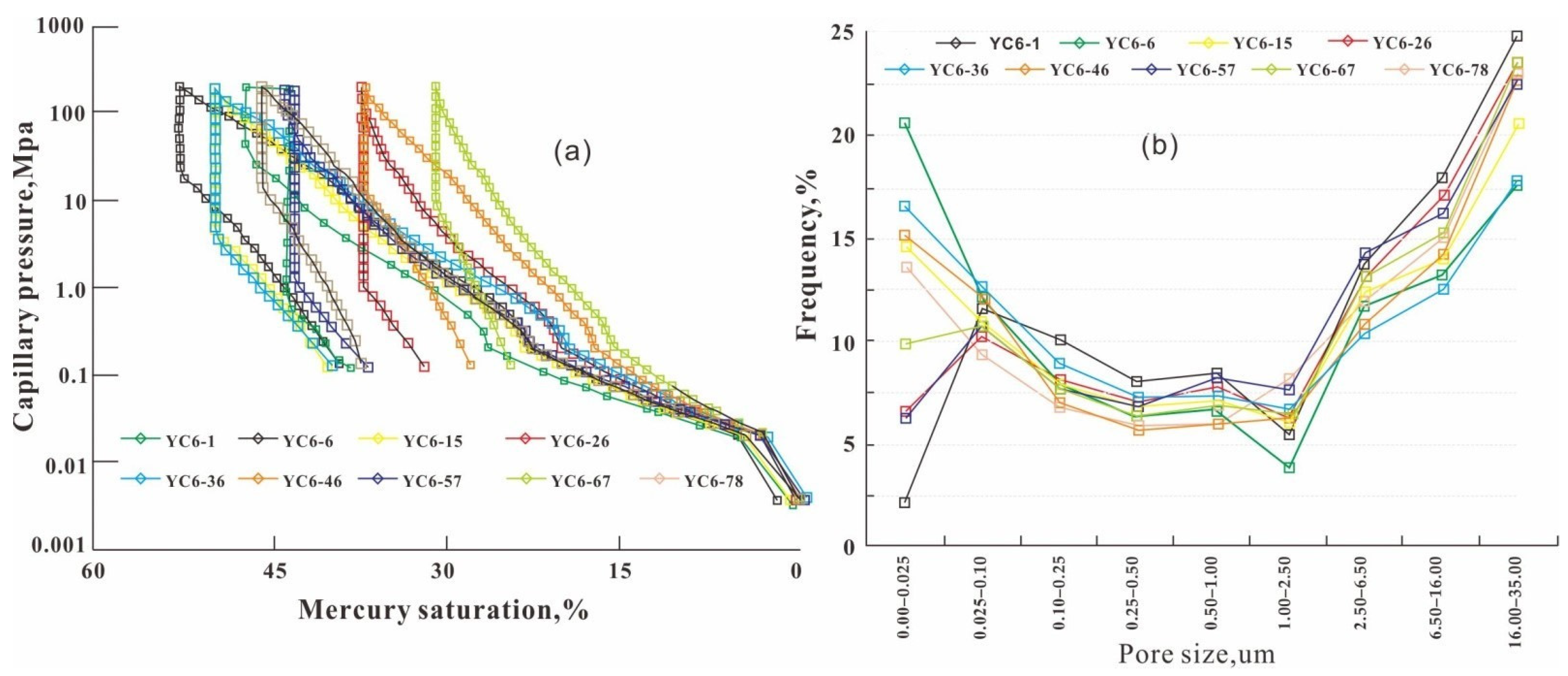

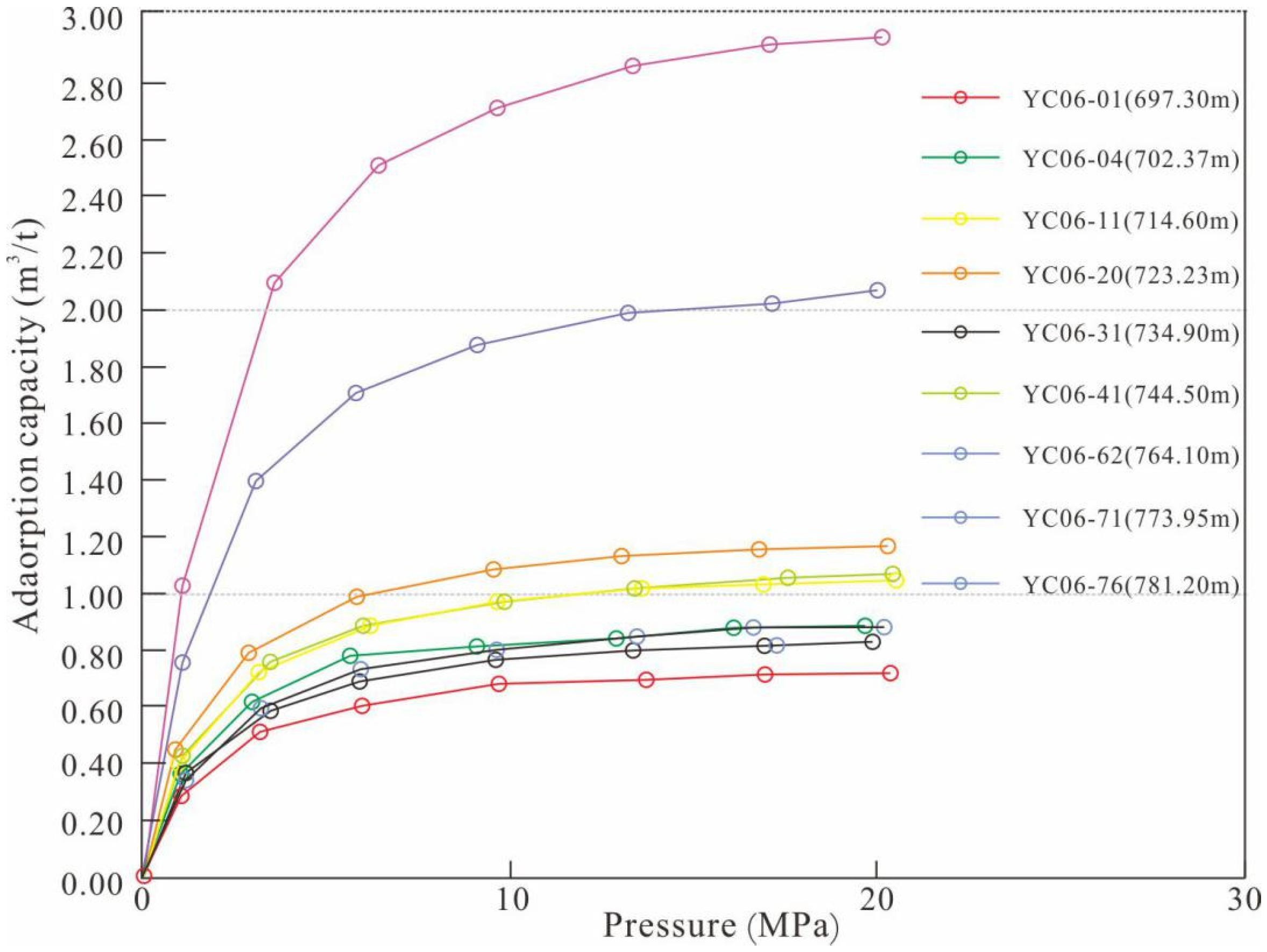
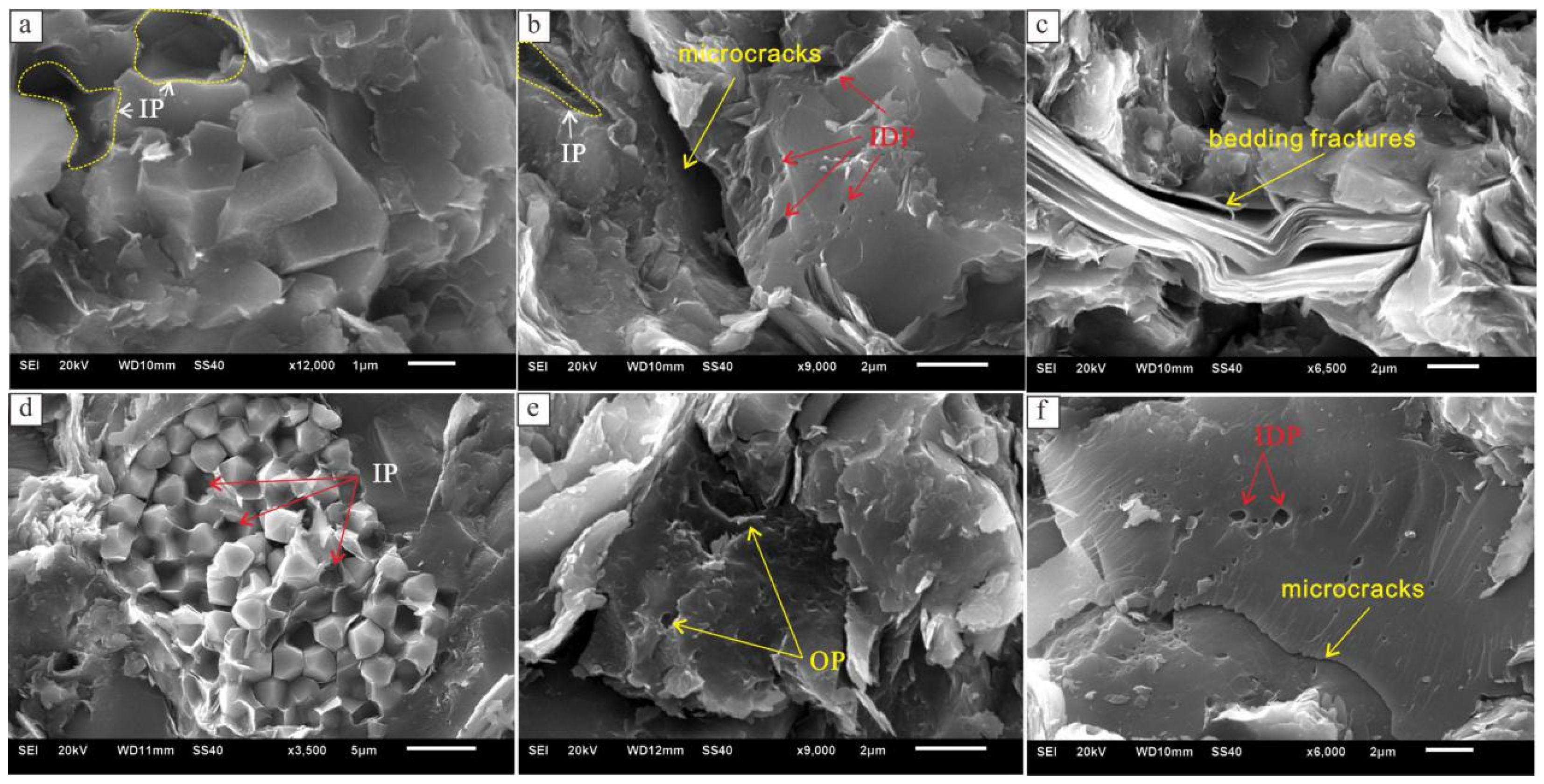

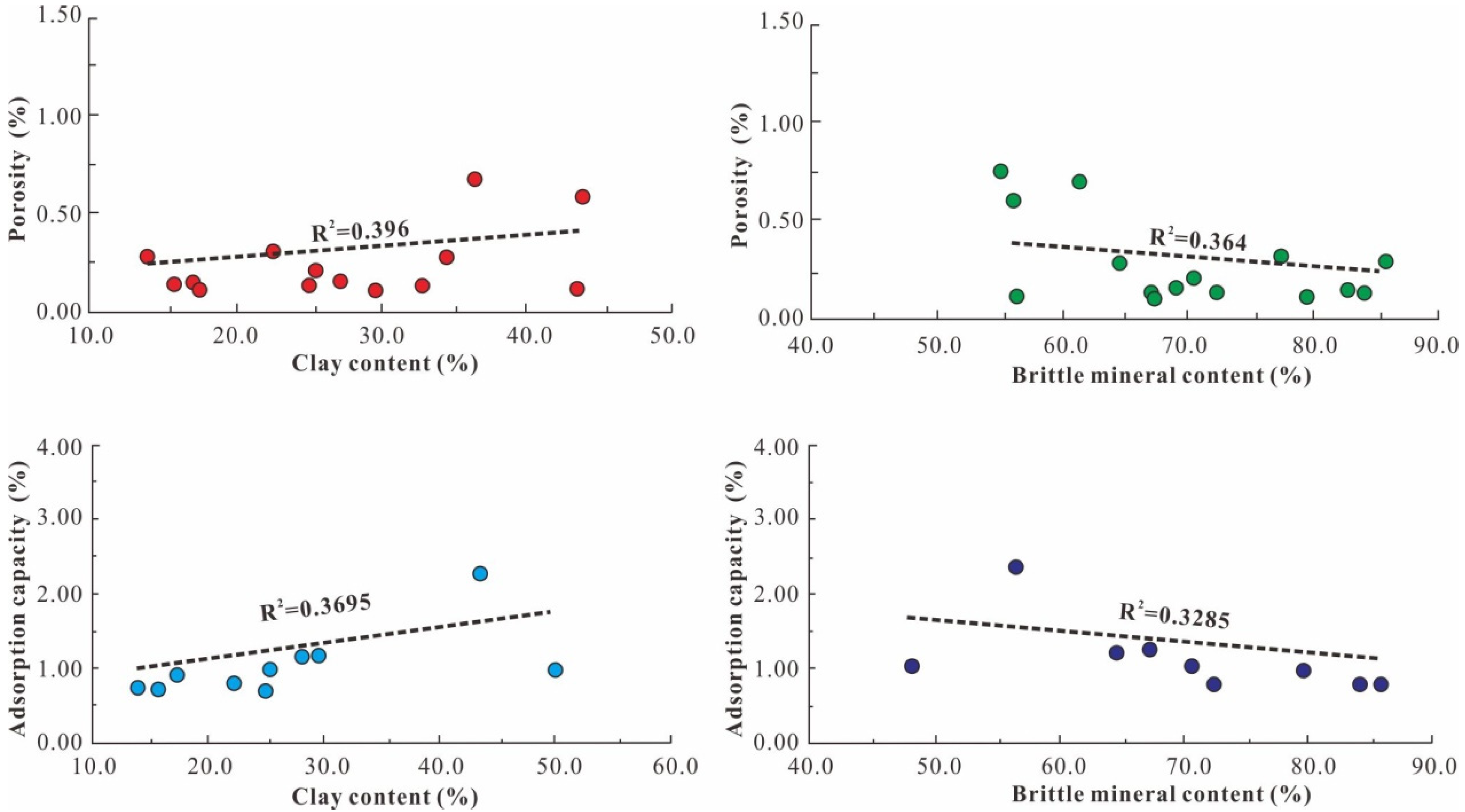
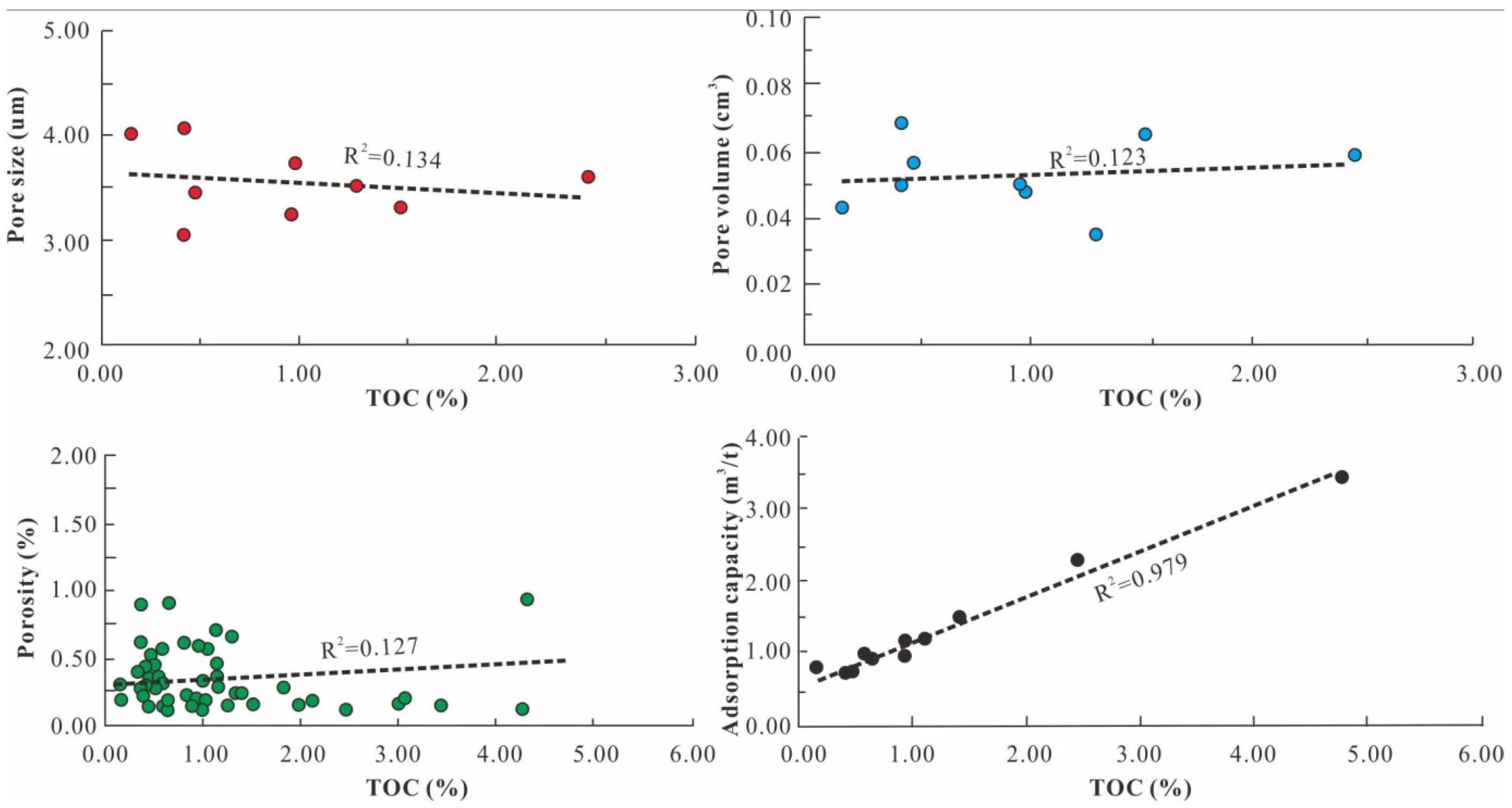
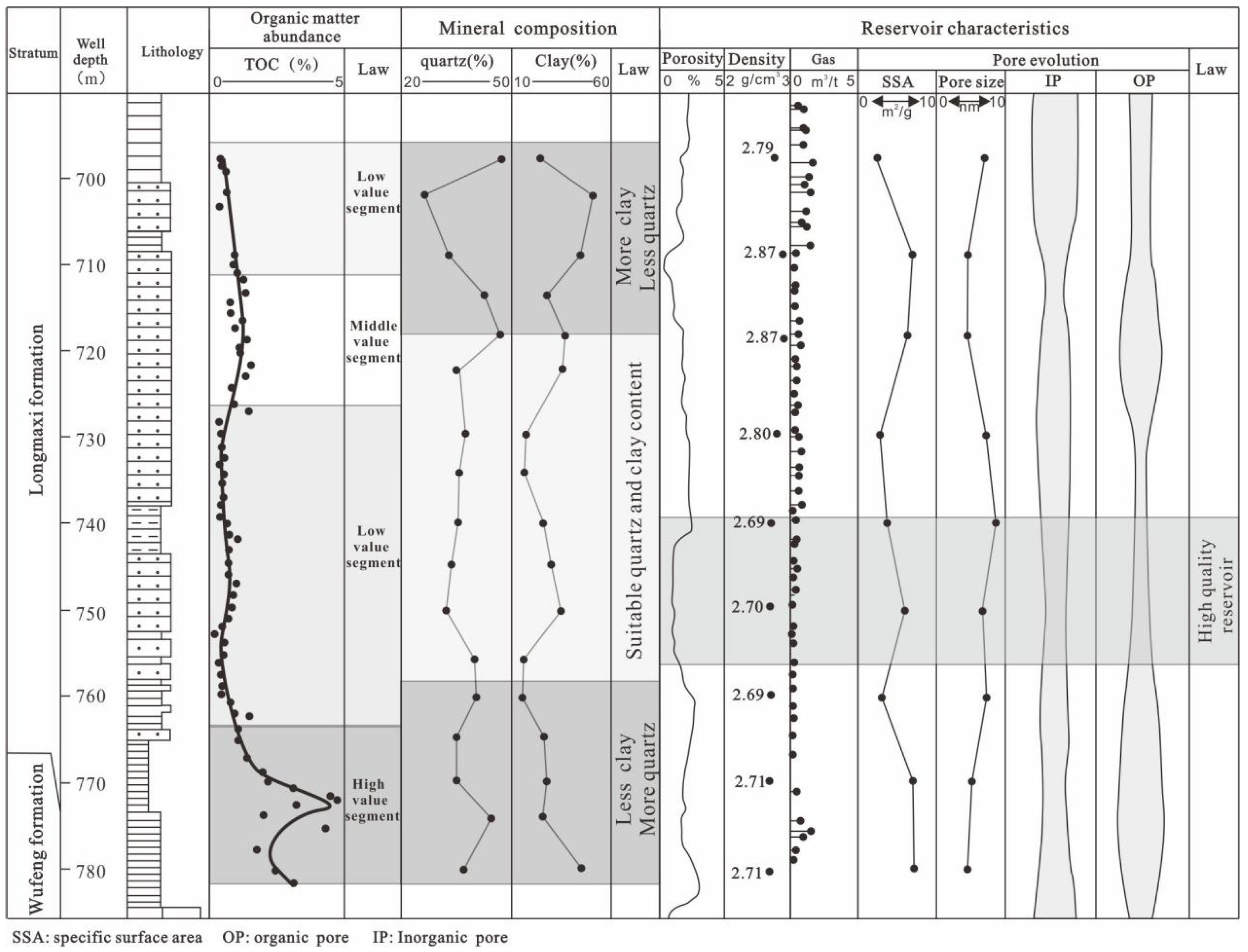
| Order Number | Sample Number | Well Depth (m) | Sapropelite (%) | Exinite (%) | Vitrinite (%) | Inertinite (%) | Ti Value | Type |
|---|---|---|---|---|---|---|---|---|
| 1 | YC6-1 | 697.3 | 96 | 0 | 2 | 2 | 92.5 | I |
| 2 | YC6-4 | 702.37 | 96 | 0 | 3 | 1 | 92.75 | I |
| 3 | YC6-6 | 708.71 | 97 | 0 | 2 | 1 | 94.5 | I |
| 4 | YC6-11 | 710.03 | 98 | 0 | 1 | 1 | 96.25 | I |
| 5 | YC6-15 | 718.1 | 97 | 0 | 1 | 2 | 94.25 | I |
| 6 | YC6-19 | 722.53 | 96 | 0 | 3 | 1 | 92.75 | I |
| 7 | YC6-26 | 729.4 | 95 | 0 | 3 | 2 | 90.75 | I |
| 8 | YC6-31 | 734.9 | 98 | 0 | 1 | 1 | 96.25 | I |
| 9 | YC6-36 | 739.8 | 96 | 0 | 1 | 3 | 92.25 | I |
| 10 | YC6-41 | 744.5 | 97 | 0 | 1 | 2 | 94.25 | I |
| 11 | YC6-46 | 749.4 | 96 | 0 | 2 | 2 | 92.5 | I |
| 12 | YC6-52 | 754.9 | 97 | 0 | 2 | 1 | 94.5 | I |
| 13 | YC6-57 | 759.57 | 95 | 0 | 2 | 3 | 90.5 | I |
| 14 | YC6-62 | 764.1 | 96 | 0 | 3 | 1 | 92.75 | I |
| 15 | YC6-67 | 769.5 | 94 | 0 | 3 | 3 | 88.75 | I |
| 16 | YC6-73 | 775.8 | 95 | 0 | 2 | 3 | 90.5 | I |
| 17 | YC6-78 | 780.6 | 97 | 0 | 2 | 1 | 94.5 | I |
| Order Number | Sample Number | Well Depth (m) | Clay Mineral Content (%) | Mixed Layer Ratio (% S) | ||||||
|---|---|---|---|---|---|---|---|---|---|---|
| K | C | I | S | I/S | C/S | I/S | C/S | |||
| 1 | YC6-1 | 697.3 | / | 16 | 19 | / | 56 | 9 | 6 | 10 |
| 2 | YC6-4 | 702.37 | / | 11 | 37 | / | 46 | 6 | 7 | 12 |
| 3 | YC6-6 | 708.71 | / | 13 | 33 | / | 49 | 5 | 9 | 14 |
| 4 | YC6-11 | 710.03 | / | 9 | 30 | / | 57 | 4 | 7 | 13 |
| 5 | YC6-15 | 718.1 | / | 10 | 24 | / | 58 | 8 | 9 | 11 |
| 6 | YC6-19 | 722.53 | / | 9 | 28 | / | 59 | 4 | 7 | 14 |
| 7 | YC6-26 | 729.4 | / | 6 | 35 | / | 56 | 3 | 8 | 15 |
| 8 | YC6-31 | 734.9 | / | 6 | 22 | / | 68 | 4 | 9 | 12 |
| 9 | YC6-36 | 739.8 | / | 10 | 20 | / | 63 | 7 | 6 | 13 |
| 10 | YC6-41 | 744.5 | / | 7 | 23 | / | 65 | 5 | 7 | 12 |
| 11 | YC6-46 | 749.4 | / | 8 | 16 | / | 69 | 7 | 9 | 11 |
| 12 | YC6-52 | 754.9 | / | 11 | 15 | / | 64 | 10 | 11 | 10 |
| 13 | YC6-57 | 759.57 | / | 9 | 23 | / | 60 | 8 | 10 | 11 |
| 14 | YC6-62 | 764.1 | / | 8 | 15 | / | 70 | 7 | 9 | 9 |
| 15 | YC6-67 | 769.5 | / | 6 | 20 | / | 69 | 5 | 10 | 12 |
| 16 | YC6-73 | 775.8 | / | 8 | 46 | / | 40 | 6 | 7 | 10 |
| 17 | YC6-78 | 780.6 | / | 10 | 20 | / | 63 | 7 | 8 | 11 |
| Order Number | Sample Number | Specific Surface Area (m2/g) | Cumulative Specific Surface Area (m2/g) | Total Pore Volume (mL/g) | Average Pore Size (nm) |
|---|---|---|---|---|---|
| 1 | YC6-1 | 2.1050 | 1.170 | 0.0023 | 7.7643 |
| 2 | YC6-6 | 7.0040 | 2.882 | 0.0027 | 5.4891 |
| 3 | YC6-15 | 6.3684 | 2.107 | 0.0026 | 4.8955 |
| 4 | YC6-26 | 2.7763 | 1.303 | 0.0026 | 7.8545 |
| 5 | YC6-36 | 3.9419 | 2.076 | 0.0043 | 8.2132 |
| 6 | YC6-46 | 6.1991 | 2.736 | 0.0047 | 6.8128 |
| 7 | YC6-57 | 2.9612 | 1.390 | 0.0027 | 7.8910 |
| 8 | YC6-67 | 7.4679 | 2.813 | 0.0039 | 5.5836 |
| 9 | YC6-78 | 7.7155 | 1.215 | 0.0014 | 4.7591 |
Publisher’s Note: MDPI stays neutral with regard to jurisdictional claims in published maps and institutional affiliations. |
© 2021 by the authors. Licensee MDPI, Basel, Switzerland. This article is an open access article distributed under the terms and conditions of the Creative Commons Attribution (CC BY) license (https://creativecommons.org/licenses/by/4.0/).
Share and Cite
Wang, S.; Wang, J.; Zhang, Y.; Li, D.; Jiao, W.; Wang, J.; Lei, Z.; Yu, Z.; Zha, X.; Tan, X. Relationship between Organic Geochemistry and Reservoir Characteristics of the Wufeng-Longmaxi Formation Shale in Southeastern Chongqing, SW China. Energies 2021, 14, 6716. https://doi.org/10.3390/en14206716
Wang S, Wang J, Zhang Y, Li D, Jiao W, Wang J, Lei Z, Yu Z, Zha X, Tan X. Relationship between Organic Geochemistry and Reservoir Characteristics of the Wufeng-Longmaxi Formation Shale in Southeastern Chongqing, SW China. Energies. 2021; 14(20):6716. https://doi.org/10.3390/en14206716
Chicago/Turabian StyleWang, Shengxiu, Jia Wang, Yuelei Zhang, Dahua Li, Weiwei Jiao, Jinxi Wang, Zhian Lei, Zhongqiang Yu, Xiaojun Zha, and Xianfeng Tan. 2021. "Relationship between Organic Geochemistry and Reservoir Characteristics of the Wufeng-Longmaxi Formation Shale in Southeastern Chongqing, SW China" Energies 14, no. 20: 6716. https://doi.org/10.3390/en14206716
APA StyleWang, S., Wang, J., Zhang, Y., Li, D., Jiao, W., Wang, J., Lei, Z., Yu, Z., Zha, X., & Tan, X. (2021). Relationship between Organic Geochemistry and Reservoir Characteristics of the Wufeng-Longmaxi Formation Shale in Southeastern Chongqing, SW China. Energies, 14(20), 6716. https://doi.org/10.3390/en14206716





